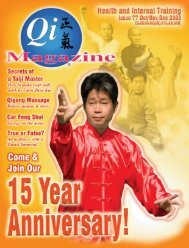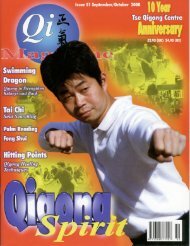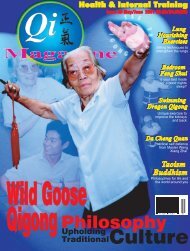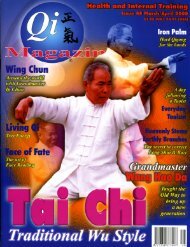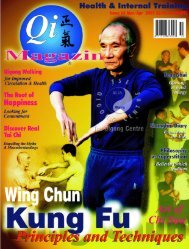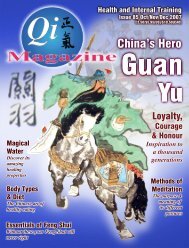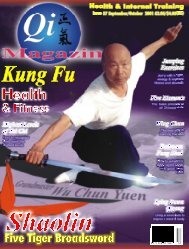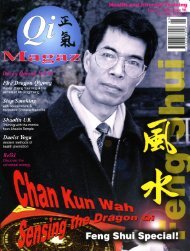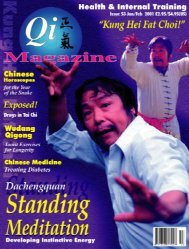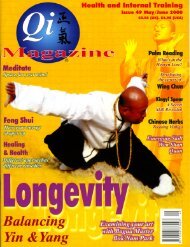Create successful ePaper yourself
Turn your PDF publications into a flip-book with our unique Google optimized e-Paper software.
Taijiquan has been practised in the West for a good number of<br />
years now. Back in the early days there was a great deal of<br />
misunderstanding. Luckily, things have come along way since then.<br />
Thank You Note<br />
In the 1970’s in England, there was<br />
little Taiji around. What little there was<br />
consisted of half understood principles<br />
and a rag bag collection of preposterous<br />
techniques. I remember watching with<br />
my mouth open as a local instructor<br />
advocated the Single Whip hooked hand<br />
as an attack to the jaw with the back of<br />
the hook! Worse was to come. He also<br />
described the Punch of Hitting the<br />
Ground as a punch to the knee. Kids,<br />
don’t try this at home! The<br />
implication seemed to be that if<br />
you just performed these forms<br />
for long enough, you’d<br />
magically be able to defend<br />
yourself against multiple<br />
attackers, using only your<br />
Cheeeeeee! The fact that<br />
no one knew how this stuff<br />
worked saved it from<br />
ridicule. Most of the time.<br />
Things have<br />
changed for the better in<br />
that respect. There are<br />
quite a few martial arts<br />
movies around nowadays<br />
that feature Taiji as the<br />
hero’s style of choice. Or,<br />
at least, the wide screen<br />
spectacular mutation of<br />
Taiji which features a lot<br />
more flying kicks,<br />
somersaults and rooftop<br />
techniques than I ever<br />
managed to learn from my Sifu!<br />
At least it’s good for westerners to<br />
see Taiji depicted as a bona fide<br />
style after years on the sideline,<br />
after years of hearing of classes where<br />
students are taught to either breathe<br />
through their chakras (!) or to take up<br />
postures that make them look terminally<br />
depressed and/or constipated!<br />
The number of times I’ve had to<br />
answer the question, “Tai Chi? How’d<br />
you make that work then?” with either a<br />
longwinded lecture on Taiji principles and<br />
practices, or with the response, “Well, if<br />
you try and punch me.”<br />
So it’s good to see Taiji depicted<br />
as a heroic endeavour, however distorted<br />
and surreal some of the fight scenes may<br />
be. And of course the training seems to<br />
consist of swirling water around in a<br />
barrel, or making leaves coil around you<br />
like a whirlwind. I tried it. I got wet. I got<br />
covered in leaves. I didn’t develop<br />
supernatural abilities. Oh well.<br />
At least there are a small handful<br />
of useful books around, one of which is<br />
from my Sifu’s pen, or at least from his<br />
word processor. But that’s it, honestly.<br />
There are simply too<br />
few decent<br />
w o r k s<br />
o n<br />
Ta i j i .<br />
Part of the<br />
problem is that Taiji is above all an<br />
activity, something one learns through<br />
one’s body, rather than the mind. The<br />
Chen style especially, with its spirals and<br />
its subtlety, is extremely difficult to follow<br />
through printed pictures. Even DVDs<br />
often can’t show what’s happening inside,<br />
the rotation of the Dantian, but only<br />
where the weight is and how the hands<br />
move. For the serious student that’s only<br />
half the story. Chen has its own flavour,<br />
a sinuous feel, which simply can’t be<br />
shown on screen unless grossly distorted.<br />
Hence some of the bizarre movie scenes<br />
- “So, you want to fight, eh? Then I shall<br />
take up the White Crane Spreads Its<br />
Wings posture, and wiggle my butt.”<br />
I tried it. My opponent didn’t run<br />
away. I still didn’t develop supernatural<br />
powers. I got wet and covered in leaves<br />
again. Oh well. Chen Taiji is my mother<br />
style. I don’t claim to be any good at it<br />
at all. But I have unlimited respect for<br />
the Chen clan, who somehow managed<br />
to create, develop and preserve this<br />
treasure, and for my Sifu, who taught<br />
“Tai Chi?<br />
How do<br />
you make<br />
that work<br />
then?”<br />
me its principles. I still find it challenging,<br />
an infinite journey - even after sixteen<br />
years I’m a beginner.<br />
My martial level within Chen is<br />
low. I don’t do the fantastic controlling<br />
techniques and throws I admire so much<br />
in my teacher and his teacher. I just (a)<br />
avoid getting hit and (b) hit the opponent.<br />
Not very pretty, not very fancy, not very<br />
advanced. But at least I can do that much,<br />
I can use my Taiji as a martial art.<br />
And I find that Chen helps<br />
enormously when I’m feeling low or<br />
suffering from a stiff back etc. Just like<br />
<strong>Qigong</strong>, a slow round of the Xinjia (new<br />
frame long form) leaves me revived and<br />
re-energised, loose and relaxed. And I<br />
always notice this fact with a mixture of<br />
page 10 Qi Magazine Apr/May/June 2007



